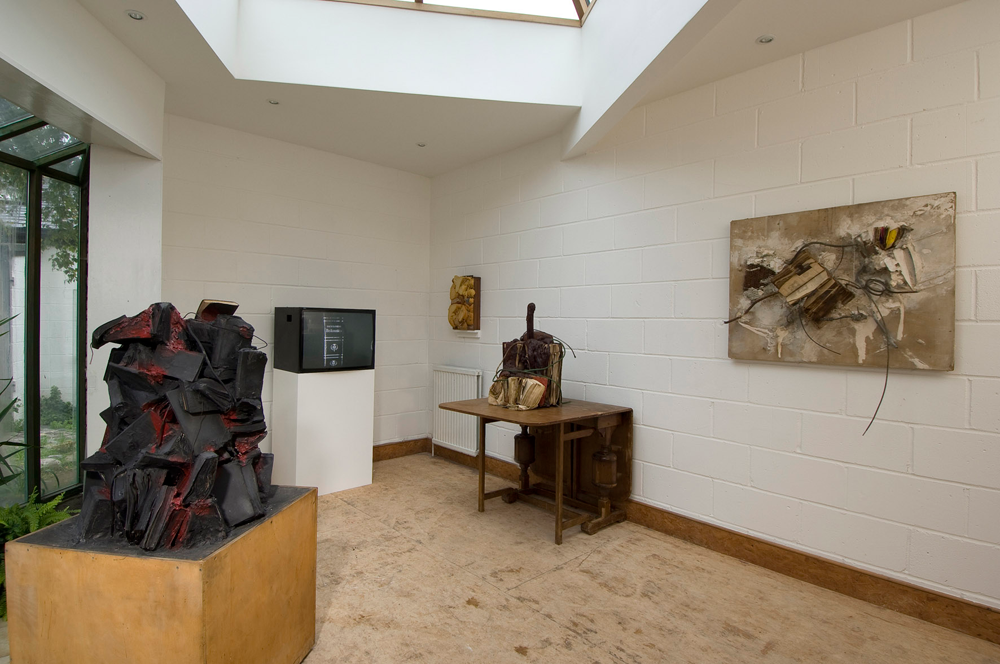A Brief History of Time
The home of John Latham, one of Britain’s most radical artists, has opened to the public two years after his death
The home of John Latham, one of Britain’s most radical artists, has opened to the public two years after his death

This isn’t the place for an in-depth analysis of Latham’s unifying conjecture, which he called ‘Flat Time’ or ‘Time-Base Theory’: that’s what Flat Time House is for. But if you know him only for notoriously chewing and regurgitating a copy of Clement Greenberg’s Art and Culture in 1966, here’s a quick and necessarily superficial primer: Latham theorized that everything in the universe, from the largest of objects to the most evanescent of thoughts, is unified by a shared quality of being an ‘event’ with a ‘time-base’ (or duration), all of these overlapping in time. Since his hypothesis, when unpacked, pointedly vaults over religious, scientific, artistic and philosophical divides, he saw its acceptance as a prerequisite if the world was to overcome its abundant disharmony – believing it would lead to people thinking about longer-term ‘events’, for instance, and curtailing the short-term thinking we’re currently, disastrously, pursuing. Distrusting language, he used art, as witnesses the five-work permanent display in the opening room of FTHo, which Latham dubbed ‘The Mind’. Time Base Roller with Graphic Score (1987) is a long canvas wrapped around a turning, wall-mounted barrel, finely marked with a sort of graphic score; the parts of the canvas we can’t see allegorize past and future, and point out that we can understand the universe only from the brief strip of time within it in which we live. Organism Somewhere (1980), meanwhile, is one of Latham’s trademark spray-paint drawings, in which the expelled molecules of paint stand, in his cosmology, for the ‘Least Event’ – the most infinitesimal of acts.
After passing through the room in which Latham wrote and which he entitled ‘The Brain’ (it’s now being used to organize his archive), we come to ‘The Hand’, a room with a big pyramidal skylight that was once the artist’s studio and is now used for temporary exhibitions. The opening show, ‘Distress of a Dictionary’, featured nine works using books and language: from Little Read Mountain (1960–2), a lumpy cluster of black-sprayed books wrapped in wire, embedded in plaster and mounted on a bowing plinth, to Tunnel Piece/PhD for Dogs (1998), a sort of reprise of a books-in-plaster piece from 1977 featuring an obedience-training book for canines (here the same book is punctured by a plastic-sheathed wire). Latham was critical of language and its properties from the start: his first published text, reproduced here in enlarged photocopy, pairs a nonsensical narrative about an ‘Athenaeum mathmaker’ with a block of mutated versions of the phrase ‘the same’ (‘the sime, the sim, the seme’ etc.). He was vexed by books because their reification of the syntactical basis of language represented both rationalism, which for him stifled the imagination, and the object-based tradition to which his time-based theory was opposed. But he also, like T.S. Eliot’s Sweeney, had to use words when he talked to us. And there’s a sense in which his art feels like a kind of elaborate reprisal for his frustrations while doing so.

There’s a video playing in ‘The Brain’ in which Latham shuffles around Flat Time House and expounds his theories. It’s a testing watch, partly because it makes the cleaned-up place you’re in suddenly seem like a missed opportunity or over-zealous erasure (his studio, with its tides of potted plants and tangles of wires and broken glass and injured books, would have been a great place to snoop in) but also because Latham is such an elliptical speaker. Parentheses balloon and nest until you wonder whether he’ll ever come back to the point he began several minutes ago; and it’s not that his work can’t be discussed using language, because his son Noa does so with wonderful lucidity in another video, shot during Latham’s contentious exhibition at Tate Britain in 2005–6 (when his work God is Great, from 1991, featuring Christian, Judaic and Islamic holy books embedded in a pane of glass, was removed for fear of giving offence). You wonder to what extent Latham’s art was symptomatic of a deeper beef with words.
What there is in Latham’s eyes when he talks, unless I’m projecting, is a kind of ambient sadness that he’s not making himself wholly understood. I saw that look from him a few times, over a decade ago, when I used to staff the till at an independent bookshop in nearby Dulwich and he’d come in and order complex volumes such as David Z. Albert’s Quantum Mechanics and Experience, from 1992 (which, visitors can discover, sits on the bookshelves in ‘The Brain’ in proximity to Danielle Steele’s rather less advanced novel Irresistible Forces, from 1999). What Latham said across the counter in respect to his ideas smoked right over my head, although when paraphrased they’re not so difficult, just heavily ramified. The melancholy still hangs in Flat Time House, although cut with tender hope and tenacity and self-possession. What reverberates most strongly here, though, however Latham’s ideas sift down, is something repeatedly stencilled on the walls: a reminder to himself (and now us) that referred to a time when, finally, the world’s consciousness would have adjusted, ready for his thought and its own betterment. It says, simply, ‘The Shift’.
Main image: John Latham's Flat Time House, London (2008)
























